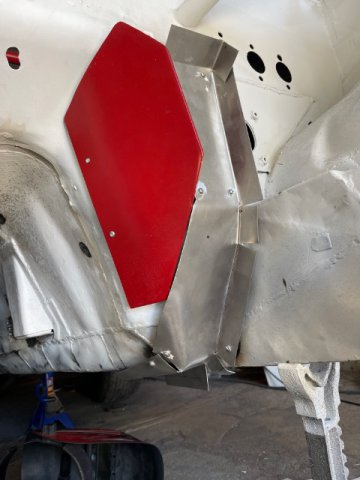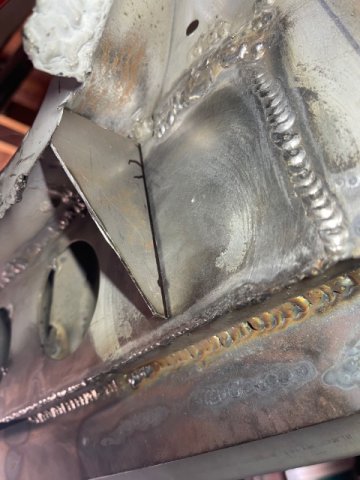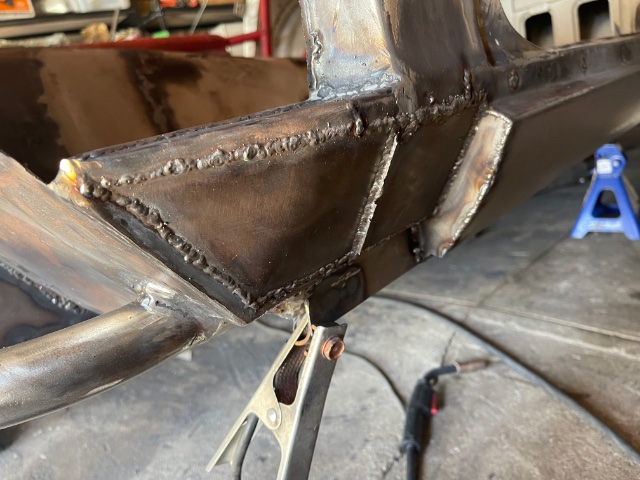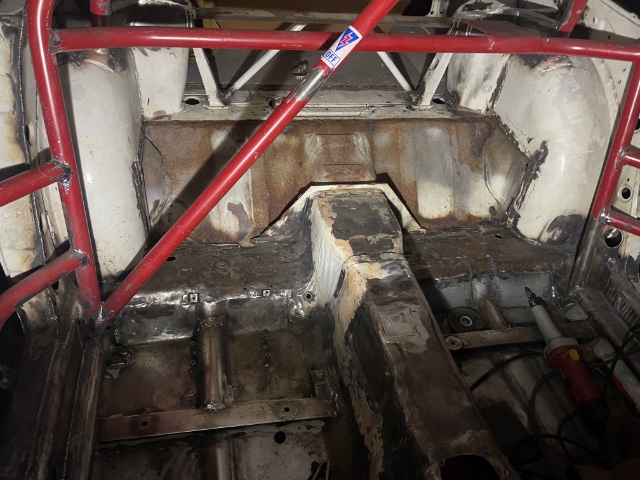
AydinZ71
Members-
Posts
1073 -
Joined
-
Last visited
-
Days Won
27
Content Type
Profiles
Forums
Blogs
Events
Gallery
Downloads
Store
Everything posted by AydinZ71
-
@tube80z Wow Cary! A few questions, if you don't ,mind! 1) Did you have a cage? If so, what spec. or wall thickness? The SCCA EP spec bar is crazy heavy... 2) have you ever tried the 5.5" flywheel-less clutches (the "flywheel" is like 6" wide, but comes with the clutch). 3) tell us more about those wheels! Were they custom? The lightest I have found to meet EP spec (15X7, 4X114) is the TE37V Rays/Volk wheels. Curious is that is still the case. 4) how expensive were those kevlar tires?
-
240z SCCA vintage race car, restoration
AydinZ71 replied to AydinZ71's topic in S30 Series - 240z, 260z, 280z
Heat shield time so I can get the mounts on before epoxy primer drivers side floor pan and tunnel. IMG_8216.MOV IMG_8217.MOV -
Greg Ira set the new EP standard (literally, rules were changed based on his petition) to 2150 w/driver. That’s probably 1950 without him (helmet, gear), plus we have to run a fire bottle, 1.25” wall roll cage, chassis reinforcement, oil accumulator… I’m shooting for about 50lbs heavier than Greg, but we’ll see!
-
R200 3.54. 3.70 close ratio 5 speed, z32 5 speed
AydinZ71 replied to Willflow's topic in Parts for Sale
The diff prices are very reasonable. Trouble is, it may be that most folks don’t want to fork the money for the unique/custom mount, CV shafts, driveshaft, etc. When folks are so inclined, they seem to be going the Ford 8.8 route. I did on the street Z (not installed) since Wlad sells everything except the diff and the driveshaft for a pretty reasonable price. -
It’s a shame you will be right outside the torque rating for the Subaru R180 LSD swap. It is net 28lbs less than an equivalent R200 LSD. That’s a lot of a spicy meat a balls. at this rate I would consider a 2017 mustang GT automatic super 8.8 rear end. It was cast aluminum structure. I weighed it, and it was only 72lbs. That is equivalent to an open R200! credit to @Invincibleextremes for that tip.
-
A musician's therapist (The $300 Z)
AydinZ71 replied to Zetsaz's topic in S30 Series - 240z, 260z, 280z
@rossman I hear ya. Il likely get the C25-550 for the street Z once she is ready. Next in-line after the race car. I learned a lot from my little T3 super-60 compressor trim. I’m going to run an air-water IC to cut-down on turbo lag, and employ some light water injection. Excited to geek out on that in time. -
Looks good! you will likely be using a thin section of body filler at those lap joints anyways, so no need to be perfect
-
A musician's therapist (The $300 Z)
AydinZ71 replied to Zetsaz's topic in S30 Series - 240z, 260z, 280z
Have you tried the cool turbo sizing calculator on Garrett's website? For my application, it looks like the G25 and G30 frame sizes were more efficient. Not cheap at $2k a pop, but efficiency goes a long way! -
Today, you might want to get a 3.9 open diff and just put in your own LSD center-section. OEM R-200 LSD’s have become quite rare and are no longer cheaper than having one made from an open diff.
-
A musician's therapist (The $300 Z)
AydinZ71 replied to Zetsaz's topic in S30 Series - 240z, 260z, 280z
😂😂 I know how it is Honestly I can’t TIG worth a damn but I suppose I would practice more if I had the equipment. It’s a lot to invest in new equipment, materials, skills, etc. when you are already limited on space and have narrow priorities (it’s a hobby, not a living). -
Help. Rusted cabin air intake, no "cover" to remove?
AydinZ71 replied to scartail's topic in S30 Series - 240z, 260z, 280z
In my humble opinion, don't bother removing the top of the cowl to access that rust. Removing spot welds is a tedious process with a panel that big. You should just cut out the piece that is rusted from inside the cab. You have to remove your dash and accessories near the rusted location. You would need to do this anyways if you were to cut it our from above. You will not want to burn these surfaces when you weld-in a new panel. You can fill it with Por-15 (as an alternative), both the paint and the seam sealer, but it will still be a temporary solution. Metal that has rusted completely through will become more and more brittle over time, even if it is incapsulated. -
A musician's therapist (The $300 Z)
AydinZ71 replied to Zetsaz's topic in S30 Series - 240z, 260z, 280z
Sweet! Yeah I don’t have a TIG I was going to butt weld with a MIG, but leave no gap with a bead on-top so I don’t penetrate too deep and make a mess inside the pipe. Sounds like you are going to have a sweet finish. Mine is for a race car afterall, so no one will ever see the welds 😂 -
A musician's therapist (The $300 Z)
AydinZ71 replied to Zetsaz's topic in S30 Series - 240z, 260z, 280z
Ooooo looks great! What equipment did you use to weld it up? Appologize if you already mentioned this higher up on the thread. in my experience it’s always harder to get butt welds to look as nice as 90/degree corners like you probably had on your V-bands. The molten metal tends to make a nice clean filet that is repeatable when welding into a corner. this is a project coming-up in a few months for me. I was planning on using an SS wire on my MIG, but ideally it should be tack welded on the car and TIG welded off the car. I don’t mind if the welds look gooopy, il just grind them down. -
yep you can do it this way too I chickened out and didn’t use a PCV (it’s a check-valve). I was worried that the valve could fail by getting fouled, and redirect boost back into the crank. I mean, something will pop and it will escape but I didn’t have enough experience to trust it. question though. Just to confirm I understand right, is it sucking on both-ends (block and valve cover)? Hmmm. The fumes will definitely escape back through the engine intake but you won’t get “flow” without fresh air coming into the block somewhere. Maybe you don’t need that cross-flow 🤷🏽♂️. Should work!
-
I route the the engine vent lines to the air intake pipe in front of the compressor. There is enough of a pressure differential to still “suck” out the crank fumes. Ideally if you want a cross-flow that will bring in fresh air through your engine crank and head cavity, you will want a breather on either your block vent or valve cover, and have one or the other plumber to your intake air. The downside to that is fumes will escape the breather when the car is off.
-
I would not worry too much about a turbo cam. Unless you are working with an engine builder with a lot of experience on the matter, I would stick with the stock cam and focus more on the quality/capacity of your intercooler, managing engine heat, turbo efficiency, etc. Not to say there is zero value is working your head for a turbo built, its just much further down the list.
-
240z SCCA vintage race car, restoration
AydinZ71 replied to AydinZ71's topic in S30 Series - 240z, 260z, 280z
Put a hoop over the flange/gusset over the diff mount. Keep from snagging my fingers there and provides a little reinforcement. -
Diff crossmember structural rigidity questions
AydinZ71 replied to Zetsaz's topic in Brakes, Wheels, Suspension and Chassis
Speaking of rockers, I did quite a bit of reinforcing when I replaced mine. I agree Jon, it became much easier when I just rebuilt it without the complex overlapping sheets. Mine was too far rusted. -
I'm Back, 1971 240Z and Yes, it will be TurboCharged
AydinZ71 replied to 240Z Turbo's topic in S30 Series - 240z, 260z, 280z
Yeah the KF vintage stuff is spot-on. I wish it was around when I purchased my floor pans and rockers. Got it all to work somehow though 🥳. Your welds look great -
Diff crossmember structural rigidity questions
AydinZ71 replied to Zetsaz's topic in Brakes, Wheels, Suspension and Chassis
These are all great ideas Jon! I think I’m going to do an X brace where my new seat rails meet the tunnel. I made mine from 2.5” SS 16-gauge square stock, cut in half. You can see them in this photo. They welded to the floor pan stiffening rail mid-way, so tying the passenger and drivers sides will go a long way. only blooper is they are not aligned. I left room behind the passenger seat for the fire suppression bottle, and the drivers seat needs to be as far back as it can be now that it is much lower. The tilton pedals also have a long throw (intentional, no booster). excited to see what you end up with on yours -
Wow… you Can still clearly see the hone. Great shape indeed!
-
Yeah I definitely don’t have any experience with the circular exhaust ports 😕 only ever ran N42’s, P90’s, and e88/31’s on L24’s. What I have heard from the old timers is the criticism was overblown.
-
@Dat73z Was OK at 8, started detonating at 16 even with severe ignition timing retard. I did not have a good means of verifying knock (no sensor), but I was able to tune it successfully at 12. Unfortunately, it only lasted 6mo like that. The rings eventually wore and had terrible blow-by. I blamed very high chamber heat as a result of high static CR and boost. It was not catastrophic in that case, literally just wore it out. My next motor was an OEM L28et which I ran at 16psi boost for years without a problem. Super low CR (7.4:1 I think?), and the turbo pistons have the rings mounted down lower from the crown vs NA. Getting the L24 to boost with the L28 manifolds, oil pan and independent EFI was not difficult. PS: the other blown L24 was catastrophic. Was at el mirage dry lake bed trying for 150mph, and blew 2 of 6 pistons (naturally #5 & 6). Boosted on 4 remaining just to get home. Max she could do was 60mph. That one I blamed on a poor tune. This was 20 years ago and I was just a young kid screwing around. Learned a lot though!
-
I think advancing chamber design is probably a combination of numerical and finite-element methods thanks to computing, and a bunch of empirical testing (R&D) at the OEM's. The high fuel efficiency standards really put a lot of pressure on engine manufacturers in the last two decades to up the static CR and get every ounce of efficiency they could. That coupled with real-time knock sensing (had not seen this on NA motors in the 90's) has really pushed the envelope on how high manufacturers are willing to push CR on pump gas. All this to say, I agree and its proprietary 🤣 I don't think us laymans understand it well enough speak intelligibly on all the variables at play, and how we would design something. I have seen RB26's routinely running 9:1 and modest boost, which I could never reproduce on an L-series (I tried...blew two L24 blocks in the process). Couldn't precisely tell you what makes the difference. Still, if someone out there has experience in this, would love to hear! PS: the F54 turbo block I am building for the street car will run 8.2:1, and around 22psi. Im going with an air-to-water to reduce the IC plumbing to help with lag. On the head, chamber polishing, deburring and smoothing out the transitions (including excess plug threads) should help a bit too. OH! and pic the right spark plug temp.
-
Diff crossmember structural rigidity questions
AydinZ71 replied to Zetsaz's topic in Brakes, Wheels, Suspension and Chassis
@JMortensen Thanks Jon! Apologies to the original post. Super timely advice! What I have to be careful of: I am allowed to remove structural material that does not subsequently require additional reinforcement (amongst other restrictions of course). So I am trying to think of ways to reinforce this area without making it painfully obvious that the new material is performing the same role as the 7lb shelf. I did leave some material there as gussets and flanges. I was planning on putting a 3/4" thin-wall hoop over that sharp edge which will stiffen the flange quite a bit and eliminate the sharp edge. hopefully that will fly. With my new seat rails and the continuation of the floor pan stiffening rails, I have a few quite stiff locations to place another crossmember across the bottom of the tunnel. I was thinking of welding one on that was positioned in such a way to still allow my driveshaft to pull in-and-out. Or I could fabricate a crossmember that can be bolted on. This tunnel is certainly the most flimsy part of the series one when the dash and OEM seat rails are removed. You can drum on it, and it sounds like a 36" wide kickdrum.





